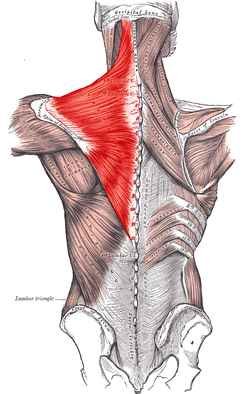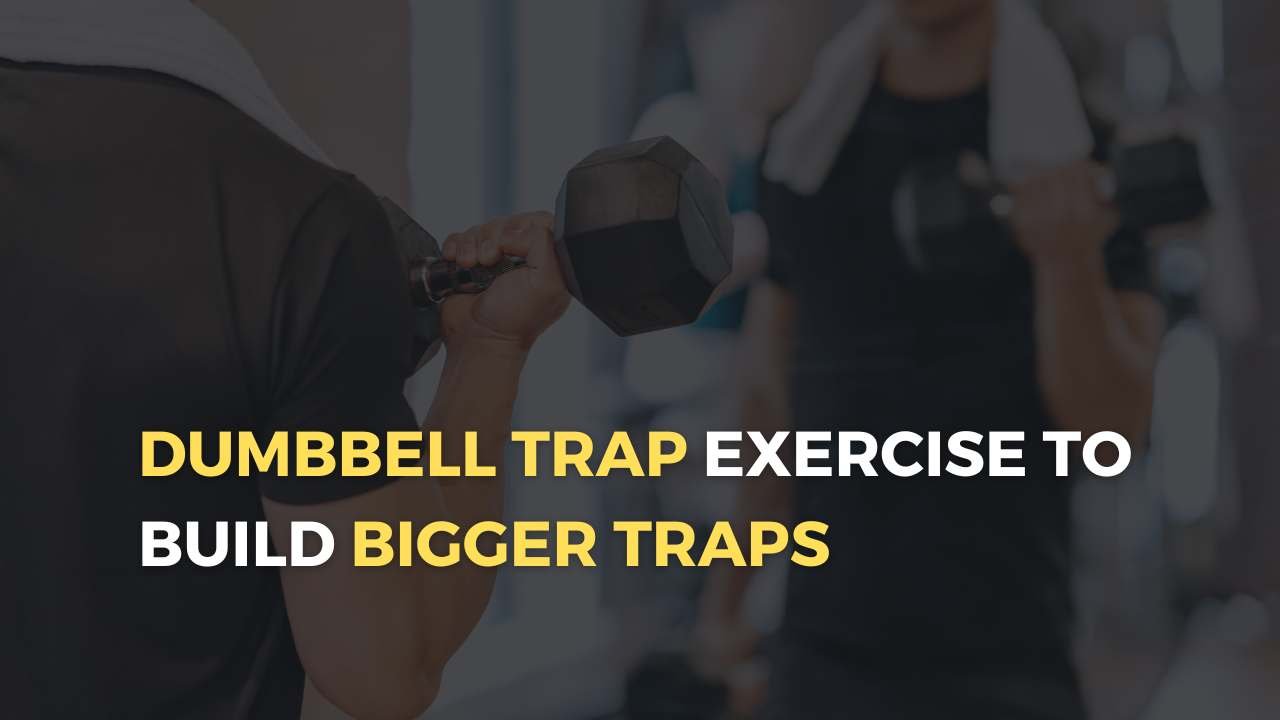In this article, we’ll be diving into the best dumbbell trap exercises to help you build bigger, stronger traps. The traps, or trapezius muscles, are often overlooked in workout routines, but they play a crucial role in maintaining good posture and giving your shoulders a more defined look.
In this post, we’ll be sharing some of the most effective dumbbell exercises for targeting the traps, as well as tips on proper form and technique. Whether you’re a beginner or a seasoned gym-goer, these exercises will help you take your trap game to the next level. So grab a pair of dumbbells and let’s get started.
The Anatomy of Trapezius Muscles

The trapezius muscle is a large, triangular muscle that extends from the base of the skull to the middle of the thoracic spine and the shoulders. It is divided into three parts: the upper fibers, middle fibers, and lower fibers.
- The upper fibers of the trapezius muscle originate from the occipital bone and the nuchal ligament at the base of the skull and insert on the lateral third of the clavicle. These fibers are responsible for elevating, retracting, and rotating the scapula.
- The middle fibers of the trapezius muscle originate from the spinous process of the thoracic vertebrae and insert on the acromion and the spine of the scapula. These fibers are responsible for adducting and rotating the scapula.
- The lower fibers of the trapezius muscle originate from the spinous process of the thoracic vertebrae and insert on the spine of the scapula. These fibers are responsible for depressing and downwardly rotating the scapula.
The trapezius muscle is innervated by the spinal accessory nerve (CN XI) and gets blood supply from the transverse cervical artery and the dorsal scapular artery.
The trapezius muscle is a key muscle for the movement of the shoulder blade and the stability of the upper body, and working out the trap muscles can help improve posture and give a more defined look to the shoulders.
13 Best Dumbbell Trap Exercises
Here are 13 best dumbbell trap exercises that will help you to get bigger traps.
1. Dumbbell Shrugs
Dumbbell shrugs are an effective exercise for targeting the trapezius muscles, also known as the traps. The exercise is performed by holding a dumbbell in each hand at arm’s length by your sides, and then shrugging your shoulders as high as you can towards your ears.
How to Perform?
- Stand with your feet shoulder-width apart and hold a dumbbell in each hand at arm’s length by your sides.
- Keep your arms straight and your elbows close to your body throughout the exercise.
- Slowly shrug your shoulders as high as you can towards your ears.
- Hold the contraction at the top for a second.
- Slowly lower your shoulders back down to the starting position.
- Repeat the movement for the desired number of reps.
Muscles Worked
Dumbbell shrugs primarily work the trapezius muscle, also known as the traps. During the shrug exercise, the trapezius muscle contracts to lift the shoulders toward the ears. The contraction of the muscle creates tension, which leads to muscle growth when the muscle is properly challenged with enough weight and volume.
2. Dumbbell Upright Rows
Dumbbell Upright Rows are also very effective exercises for targeting the trapezius muscles.
How to Perform?
- Stand with your feet shoulder-width apart and hold a dumbbell in each hand at arm’s length in front of your thighs.
- Keep your core tight and your back straight throughout the exercise.
- Slowly raise the dumbbells to your chest while keeping your elbows higher than your wrists.
- Hold the contraction at the top for a second.
- Slowly lower the dumbbells back to the starting position.
- Repeat the movement for the desired number of reps.
Muscles Worked
The primary muscle worked with dumbbell upright rows is the deltoid muscle in the shoulder. Additionally, the trapezius and the biceps muscles are also worked during this exercise.
3. Dumbbell High Pulls
Dumbbell high pulls primarily work the muscles in the upper back and shoulders, specifically the deltoids, trapezius, and latissimus dorsi. The biceps and forearms also work as stabilizers during the exercise.
How to perform?
- Start by standing with your feet shoulder-width apart and your knees slightly bent.
- Hold a dumbbell in each hand with an overhand grip, palms facing your body.
- Keep your arms straight and raise the dumbbells to hip level, keeping your elbows pointed out to the sides.
- From this position, explosively pull the dumbbells upward by driving your elbows up and out to the sides.
- As the dumbbells reach chest height, rotate your wrists so that your palms face the ceiling.
- Lower the dumbbells back to the starting position and repeat the movement for the desired number of reps.
Muscles Worked
Upper back, shoulders, deltoids (anterior, medial and posterior) , trapezius, and latissimus dorsi.
4. Dumbbell Bent-Over Rows
Dumbbell Bent-Over Rows target the muscles of the upper back, lats, and biceps. The exercise is performed by holding a dumbbell in each hand and bending forward at the hips while keeping your back straight. Then pull the weights towards your body while keeping your elbows close to your sides.
How to perform?
- Stand with your feet shoulder-width apart and bend at the waist, keeping your back straight and your knees slightly bent.
- Hold a dumbbell in each hand and let them hang at arm’s length.
- Row the dumbbells to your sides, keeping your elbows close to your body.
- Lower the dumbbells back to the starting position.
Muscles Worked
Latissimus dorsi, trapezius, rhomboids, posterior deltoids, biceps, and forearms.
5. Dumbbell Lateral Raises
Dumbbell lateral raises primarily target the shoulders (deltoids). The exercise is performed by holding a dumbbell in each hand at arm’s length by your sides, with your palms facing your body.
How to perform?
- Stand or sit with your feet shoulder-width apart and your knees slightly bent.
- Hold a dumbbell in each hand with your palms facing your body and your arms extended straight down by your sides.
- Keep your elbows slightly bent and raise your arms out to the sides until they are parallel to the floor.
- Pause for a moment at the top of the movement, then slowly lower your arms back to the starting position.
- Repeat the movement for the desired number of repetitions, usually 8-12 reps, 3-4 sets.
Muscles Worked
Medial Deltoids, Anterior Deltoids, Rotator cuff muscles, Supraspinatus, Trapezius, Biceps brachii
6. Dumbbell Rear Delt Fly
The Dumbbell Rear Delt Fly, also known as a bent-over lateral raise, is an exercise that targets the muscles in the back of the shoulders (posterior deltoids).
How to perform?
- Stand with your feet shoulder-width apart and bend forward at your hips until your upper body is parallel to the floor.
- Hold a dumbbell in each hand with your palms facing each other and your arms extended straight down towards the floor.
- Keep your elbows slightly bent and raise your arms out to the sides and back until they are parallel to the floor.
- Pause for a moment at the top of the movement and then slowly lower your arms back to the starting position.
- Repeat the movement for the desired number of repetitions, usually 8-12 reps, 3-4 sets
Muscles Worked
Posterior deltoids, Rhomboids, Trapezius, Infraspinatus, Teres minor, and Latissimus Dorsi
7. Dumbbell Face Pulls
Dumbbell face pulls target the muscles of the upper back, shoulders, and arms. The exercise is performed by pulling a weight towards the face while keeping the elbows high and the palms facing each other.
How to perform?
- Stand or sit with your feet shoulder-width apart, and your knees slightly bent.
- Hold a dumbbell in each hand with your palms facing each other.
- Bend your elbows and bring the dumbbells to your chest.
- Keep your elbows high, and pull the dumbbells towards your face, squeezing your shoulder blades together at the top of the movement.
- Pause for a moment at the top of the movement, then slowly lower the dumbbells back to the starting position.
- Repeat the movement for the desired number of repetitions, usually 8-12 reps, 3-4 sets.
Muscles Worked
Posterior deltoids, Rhomboids, Trapezius, Infraspinatus, Teres minor, Biceps brachii, Triceps brachii, and Rotator cuff muscles
8. Dumbbell Pull-Overs
Dumbbell pull-overs target the muscles of the upper back, specifically the trapezius (traps) and lats. The exercise is performed by lying on a bench and holding a dumbbell with both hands, then extending the arms behind the head and over the head, bringing the weight towards the floor, and then returning to the starting position.
How to perform?
- Lie on a flat bench with your head and shoulders hanging off the end of the bench.
- Hold a dumbbell with both hands and keep your arms straight.
- Keep your core tight and your glutes on the bench.
- Bring the weight over your head and towards the floor, keeping your arms straight.
- Pause for a moment at the bottom of the movement, then slowly lift the weight back to the starting position.
- Repeat the movement for the desired number of repetitions, usually 8-12 reps, 3-4 sets.
Muscles Worked
Latissimus Dorsi, Pectoralis Major, Triceps brachii, Serratus Anterior, Rhomboids, Trapezius, Deltoids, Lower and middle traps
9. Dumbbell Hammer Upright Rows
Dumbbell hammer upright rows target the muscles of the shoulders, upper back, and arms. The exercise is performed by holding a dumbbell in each hand with a hammer grip (palms facing each other) and lifting the weights up to the shoulders while keeping the elbows high. This exercise can be done to build strength and definition in the shoulders, upper back, and arms.
How to perform?
- Stand with your feet shoulder-width apart and your knees slightly bent.
- Hold a dumbbell in each hand with a hammer grip (palms facing each other).
- Keeping your elbows close to your body, lift the dumbbells up to your shoulders.
- Pause for a moment at the top of the movement, then slowly lower the dumbbells back to the starting position.
- Repeat the movement for the desired number of repetitions, usually 8-12 reps, 3-4 sets
Muscles Worked
Deltoids, Trapezius, Infraspinatus, Teres minor, Biceps brachii, forearms
10. Dumbbell Scaption
Dumbbell scaption targets the muscles of the shoulders, specifically the middle deltoids. The exercise is performed by holding a dumbbell in each hand and raising the arms out to the sides, stopping at about a 30-degree angle from the body.
How to perform?
- Stand with your feet shoulder-width apart and your knees slightly bent.
- Hold a dumbbell in each hand with your palms facing forward.
- Raise the dumbbells out to the sides, stopping at about a 30-degree angle from the body.
- Pause for a moment at the top of the movement, then slowly lower the dumbbells back to the starting position.
- Repeat the movement for the desired number of repetitions, usually 8-12 reps, 3-4 sets
Muscles Worked
Deltoids, Rotator cuff muscles, Trapezius, Biceps brachii, Serratus Anterior.
11. Dumbbell Incline Shrugs
Dumbbell incline shrugs target the muscles of the upper back, specifically the trapezius (traps). The exercise is performed by holding a dumbbell in each hand and shrugging the shoulders while sitting on an incline bench.
How to perform?
- Sit on an incline bench with your feet flat on the floor and your knees bent.
- Hold a dumbbell in each hand with your palms facing your thighs.
- Keeping your arms straight, shrug your shoulders up towards your ears.
- Pause for a moment at the top of the movement, then slowly lower your shoulders back to the starting position.
- Repeat the movement for the desired number of repetitions, usually 8-12 reps, 3-4 sets
Muscles Worked
Trapezius, Levator Scapulae, Rhomboids
12. Dumbbell Seated Rows
Dumbbell Seated Rows primarily target the muscles of the upper back, including the rhomboids, lats, and lower traps. The exercise is performed by sitting on a bench or a seat and holding a dumbbell in each hand, then pulling the weights towards the body while keeping the elbows close to the body.
How to perform?
- Sit on a bench or a seat with your feet flat on the floor and your knees bent.
- Hold a dumbbell in each hand with your palms facing each other.
- Keep your core tight and your back straight, and lean forward slightly at the hips.
- Pull the dumbbells towards your body, keeping your elbows close to your sides.
- Pause for a moment at the top of the movement, then slowly lower the dumbbells back to the starting position.
- Repeat the movement for the desired number of repetitions, usually 8-12 reps, 3-4 sets
Muscles Worked
Latissimus dorsi, Rhomboids, Trapezius, Posterior deltoids, Teres Major, Infraspinatus, Biceps brachii
13. Dumbbell Y-Raises
Dumbbell Y-Raises are a weightlifting exercise that primarily target the muscles of the shoulders, specifically the middle deltoids. The exercise is performed by holding a dumbbell in each hand and raising your arms out to the sides, stopping at about a 30-degree angle from the body.
How to perform?
- Stand with your feet shoulder-width apart and your knees slightly bent.
- Hold a dumbbell in each hand with your palms facing each other.
- Raise your arms out to the sides, stopping at about a 30-degree angle from the body, as if you were forming a “Y” shape with your body.
- Pause for a moment at the top of the movement, then slowly lower your arms back to the starting position.
- Repeat the movement for the desired number of repetitions, usually 8-12 reps, 3-4 sets
Muscles Worked
Middle Deltoid, Anterior Deltoid, Rotator cuff muscles, Trapezius.
Frequently Asked Questions
Can I get bigger traps with dumbbells at home?
Yes, you can definitely get bigger traps with dumbbells at home. You can perform the above exercises to target the traps specifically and help build mass and strength in that area.
Do you need heavy weights on the traps?
You don’t necessarily need heavy weights to build mass and strength in your traps. The key to building muscle in any area of your body is progressive overload, which means gradually increasing the weight or reps over time. You can start with lighter weights and work your way up as your traps adapt to the stress.
That being said, the traps are a muscle group that responds well to heavy weights, so if you are comfortable and able to handle them, you can use heavier weights to challenge your traps and promote muscle growth. It’s important to use proper form when using heavy weights to avoid injury, and if you’re not sure, it’s always a good idea to consult a trainer or coach.
Conclusion
It is important to note that proper form and technique is crucial to avoid injuries, make sure to use weights that are appropriate for you and start with fewer reps and sets then gradually increase as you progress.
You can also check out best upper chest workout with dumbbells.




